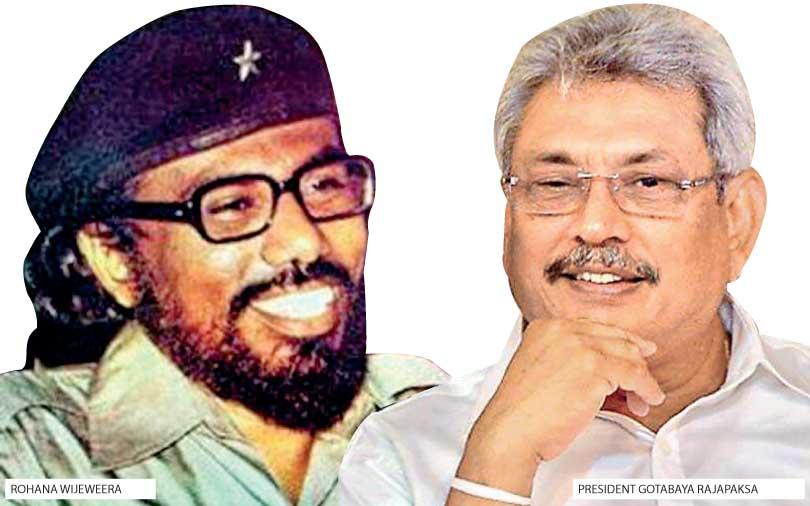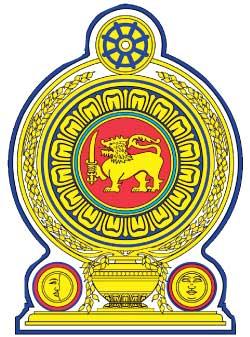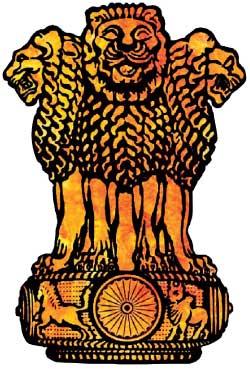Reply To:
Name - Reply Comment

 When one makes a comparison between the regime’s struggles to defeat two of the biggest rebel uprisings the names of JVP founder Rohana Wijeweera and Gotabaya Rajapaksa, the present president of Sri Lanka, surface quite naturally.
When one makes a comparison between the regime’s struggles to defeat two of the biggest rebel uprisings the names of JVP founder Rohana Wijeweera and Gotabaya Rajapaksa, the present president of Sri Lanka, surface quite naturally.
Wijeweera’s struggle was to defeat the UNP led regime and to drive away the Indian Peace Keeping Force (IPKF) and for that purpose he eventually made his cadres take to arms. There is JVP literature which appeared in newspapers that stakes a claim that the JVP army, named the Sri Lanka Patriotic Liberation Army, engaged in combat with the IPKF. Rajapaksa’s cause was a little different, but his cause also involved the use of weapons which led to a blood bath. In both these armed struggles it were the youth in the country who was mostly killed.
Wijeweera was killed in one arms struggle while Rajapaksa emerged as a hero during his struggle where he played a major role in defeating an armed rebel organization, the LTTE.
Wijeweera had his eyes set on becoming the head of state and also portrayed the existing UNP regime as incapable of finding solutions to problems faced by the downtrodden masses. Wijeweera felt the heartbeat of the masses. He could relate to the less affluent and was friendly, just like the new ‘face’ that Rajapaksa is portraying. When the JVP leader spoke, people listened attentively. Rajapaksa also boasts of a similar skill, certainly now if not before.
Their love for this ‘paradise’ island was evident. They both promoted the idea of loving the nation or putting country before self.
Our comparison between the two starts after Rajapaksa took to politics and while doing so portrayed himself as a ‘problem solver’ more than being a dictator
But the one thing that sets them apart is the difference in time when they were in positions to call the shots. Rajapaksa was probably not a very high ranked officer in the Sri Lanka Army when Wijeweera was in the driving seat with his growing insurgent organization. The military man spoken about most with regard to the squashing of the JVP back then was Brigadier Janaka Perera; next to state minister of defence Ranjan Wijeratne.
 A product of Friendship University of Russia, Wijeweera was a serious politician and made members of his organization eat out of his hand in terms of following instructions. There was no disobeying him and this pattern was even followed at home by his family members who were on the run along with him during the last years of his life. Communication was not at a high like during the time Rajapaksa was defence secretary. This made Wijeweera move around in jungles and later in the hill country; at one time living in the disguise of a tea planter. It was also a time when the downtrodden masses were looking up to the JVP as the third political force because they were let down both by the UNP and the SLFP, according to Wijeweera.
A product of Friendship University of Russia, Wijeweera was a serious politician and made members of his organization eat out of his hand in terms of following instructions. There was no disobeying him and this pattern was even followed at home by his family members who were on the run along with him during the last years of his life. Communication was not at a high like during the time Rajapaksa was defence secretary. This made Wijeweera move around in jungles and later in the hill country; at one time living in the disguise of a tea planter. It was also a time when the downtrodden masses were looking up to the JVP as the third political force because they were let down both by the UNP and the SLFP, according to Wijeweera.
Like Wijeweera, being ready for hardcore politics following his return from Russia, Rajapaksa too seemed to have upgraded his personality when returning to Sri Lanka after living for a while in the USA. Rajapkasa retired from the Army in 1992 after serving the military for 20 years (Between 1972-1992). This member of the Rajapaksa clan was 43 years old then.
Our comparison between the two starts after Rajapaksa took to politics and while doing so portrayed himself as a ‘problem solver’ more than being a dictator. We can just pose the question what approach Rajapaksa would have taken to defeat the insurgent at politics if Wijeweera was alive today and the two were to battle each other?
Wijeweera, if he lived today, would be a senior citizen of this nation and would have been at the ripe old age of 77. Rajapaksa is 71. What is evident is that Wijeweera failed to establish a third force in politics while Rajapaksa succeeded. At one time establishing a third force in Sri Lankan politics was considered unthinkable.
Probably what contributed to the downfall of Wijeweera was his tendency to contradict himself about thoughts on democracy. The JVP Leader when captured by the Army stressed that his fight was against the continued stay of the UNP regime in power against the will of the people and that he didn’t wish to be a threat to democracy. But the JVP he led wanted to assume power in the country through the bullet and not by a ballot; the former is considered an undemocratic way of assuming power.
Rajapaksa on the other hand allows for dissent and difference of opinion. The JVP never allowed this liberty to the people. The present president of the country is yet to disperse a gathering of protesters. Rajapaksa has also shown the will to accommodate protesters for talks. He has even allocated a place in central Colombo for people to agitate if they have grievances.
As for Wijeweera he saw India’s interests in Sri Lanka growing eternally. Wijeweera saw signs in the flags and state symbols of the two countries revealing a story about India
We all remember the letter the JVP issued on September 5, 1989 demanding those serving the Army to vacate their posts and stop protecting VIPs of the government. Many consider this decision to have had a drastic effect on  the already wobbling organization which is best described by the saying ‘the straw that broke the camel’s back’.
the already wobbling organization which is best described by the saying ‘the straw that broke the camel’s back’.
Like Wijeweera, Rajapaksa’s life was also exposed to threats. The former defence secretary survived an assassination attempt in 2006 in Colombo. He survived the last stages of the war and survived to relate a story of a civil war in which he was a key stakeholder in the side that was victorious. Luck was on his side as against Wijeweera whose share of luck in surviving the hardest of times was akin to standing on thin ice.
Both Wijeweera and Rajapaksa had their theories about threats to the island nation; the former always being sceptical of India’s influence on Sri Lanka and the latter showing the need to be always vigilant of any terrorist uprising. How true both were.
Last year there was a series of bombings carried out by an extremist Muslim terrorist organisation during which many churches were bombed and scores of devotees were killed.
As for Wijeweera he saw India’s interests in Sri Lanka growing eternally. More than the Indian interest in the welfare of the Tamil community here, Wijeweera saw signs in the flags and state symbols of the two countries revealing a story about India having intentions of sticking close and never taking its eyes off its closest neighbour. According to an article carried in the weekend edition of the Sinhala newspaper ‘Mawbima’, its writer Udeni Saman Kumara notes that the state emblems of Sri Lanka and India sporting the Lion and the Dharma Chakra suggest that India will never free Sri Lanka from its clutches!